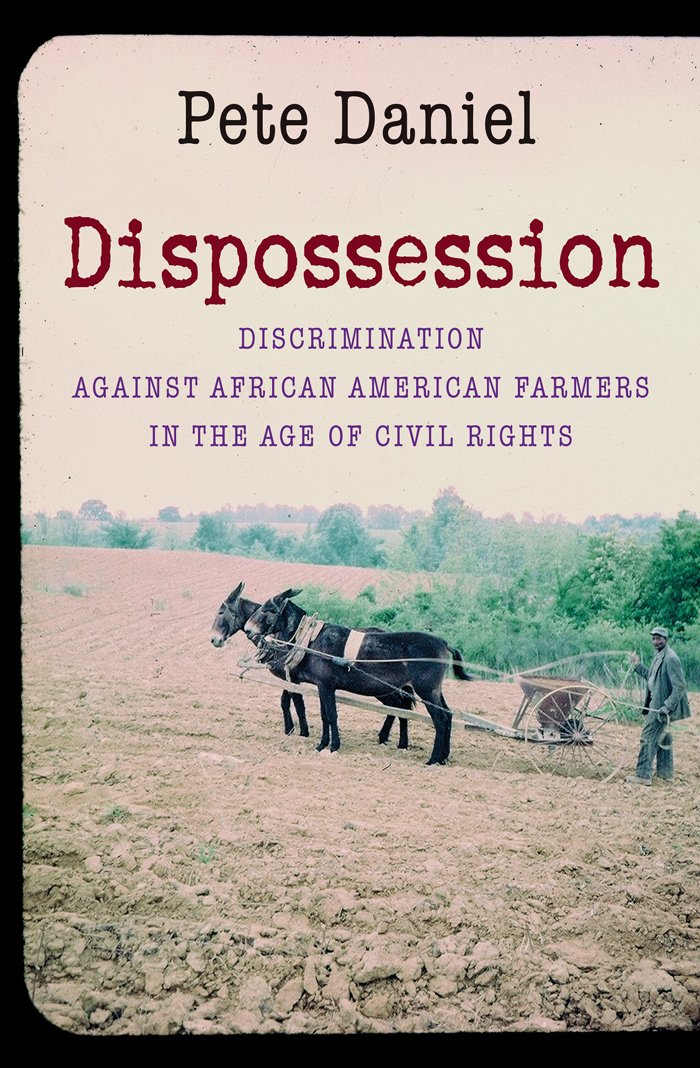Book Review by Pam Dawling
Dispossession is a very gripping and valuable book, a combination of detailed history and personal stories, making plain how African American farmers were systematically deprived of their land and livelihood by the white-controlled agri-government during the third quarter of the twentieth century. Yes, the same “civil rights era†when some substantial success was made against racial discrimination. At that same time, agriculture was experiencing big changes leading to increased yields. Mechanization, herbicides and pesticides reduced the number of farmworkers needed. Between 1940 and 1974, the number of African American farmers fell by an astounding 93 percent, compared with a much smaller number of white farmers leaving the land. The magnitude of this decline was personal tragedy to those farmers and it was not coincidental – white people in the USDA manipulated the distribution of information, loans, grants and of positions of power, to favor white farmers. This shameful part of American history only slowly became apparent to me, a white immigrant farmer, as I noticed USDA reparation efforts within phrases like “historically under-servedâ€. Quite the under-statement!
The USDA promoted capital-intensive agriculture and subsidized already wealthy farmers headed in this direction. At the same time, the USDA put barriers in the way of women and minority farmers seeking a fair share of resources, including the important acreage allotments (approval to grow certain acreages of wheat, cotton, corn, tobacco, peanuts, and rice). These production controls had been introduced in the mid-1950s to prevent surplus production. Every couple of years the rules changed, and not all farmers were given the needed information to apply for that year’s permits and price support mechanisms.
The USDA had been run by white men since it was formed in 1862, and, with the exception of the Negro Extension Service, African Americans were excluded from any decision-making positions. Many individuals and organizations worked to get USDA to remove the discrimination, and to help African Americans get a fair distribution of the resources. Pete Daniel’s book focuses on the South in the years before the 1999 Pigford v. Glickman class action suit, which won compensation for discrimination occurring after 1981. Previously there was no real check on USDA discrimination. The class action suit opened the way for similar suits by women, Native Americans and Latinx farmers.
The first couple of chapters of the book give the overview and make for information-packed reading. After setting the stage, Pete Daniel shares individual stories of farmers, civil rights volunteers, and black extension agents. The first chapter is called “Intended Consequencesâ€. Although the 1964 Civil Rights Act banned discrimination, the US Commission on Civil Rights (created to monitor the application of the Act) reported in March 1965 of a broad range of discriminatory practices in every office of the USDA. It took 30 years before Timothy Pigford brought the suit that found the USDA guilty of widespread discrimination. The broken promise of “Forty acres and a mule†for every soldier in the Civil War was followed by decades of subverted laws and farming programs that left black farmers unjustly treated. And Pigford did not fix everything! Congress did not make funds available until 2010, by which time many of the mistreated farmers had died or lost their farms. And all the farmers discriminated against before 1981 received no recompense.
At the very time that laws were supposedly protecting Black people from bias, Black farmers were suffering the most crippling discrimination. It was very hard for sharecroppers to become tenant farmers, with control over the sale of their own crops. Their fortunes were eroded by labor laws, bad weather, bankers, landlords and pests. Diets were poor, and so was sanitation and health, as well as childhood schooling. Many tenants and sharecroppers became redundant as machinery took their jobs.
Black farmers who succeeded did so by cultivating white support, as advised by Booker T Washington. The decline of Black farmers after World War II was in strong contrast with their gains in the 50 years after Emancipation from slavery. Over-production led to lower prices, which led to desperate farmers.
The USDA was founded during the Civil War to encourage better farming methods throughout the country. In 1862, Congress funded land-grant universities in each state. Since Southern white schools would not admit Black students, Congress funded the African American land grant colleges in 1890 (with fewer resources than went to the white colleges).
The 1887 Hatch Act established agricultural research stations, and Congress established the segregated and unequal Federal Extension Service in 1914, operating out of the land-grant universities, providing some farmers with advice and information. The organization of the Extension Service was convoluted, territorial and discriminatory, and extension agents wielded enormous power. The confused structure lead to claims that some agents were employed by the county and some were federal employees. (All, in fact, were part of the federal civil service retirement system and held civil service appointments.)
White agents oversaw the Negro Extension Service, which was hosted by the 1890 land-grant colleges. Black agents got lower pay and poorer equipment, but the jobs offered respectability and the opportunity to serve rural people. Women working for the Home Demonstration service got a lot of satisfaction from the work. African American Extension agents had to tread a fine line when addressing the needs of Black famers and preserving goodwill with whites. Many whites only tolerated black agents who did not challenge their authority or disrupt farm labor.
A white agent with 6 years’ work experience with the extension service was paid $375 a month, while a black agent with 14 years’ experience was paid only $212. The Black agent received considerably less information from the office, and was kept out of the decision-making loop. In some places, the furniture for the Black agent’s office was much poorer quality than that in the white agent’s office; Black agents received no vehicles, and little demonstration materials and had to do their own typing. Black agents were usually isolated from decision-making and rarely interacted with their white counterparts. Because the USDA functioned in isolation, the white leadership in USDA had not been challenged about their discriminatory practices.
Loans often went to wealthier farmers rather than the poor farmers for whom the program was intended. Black farmers assumed many of the programs were for whites only, and did not apply. Or they decided that the costs of upsetting the applecart were higher than the costs of managing without those resources. As pressure mounted on the agricultural organizations to appoint or elect African Americans, whites turned to intimidation, tokenism and duplicity, such as getting permission to include the name of an African American on a committee, but then not telling the person which committee or when they met. His name was sought to satisfy requirements, but his participation was not wanted.
During early 1964, the Student Nonviolent Coordinating Committee was preparing for the Freedom Summer, and the US Commission on Civil Rights turned its attention to the USDA. This 6-person commission made investigations and reports but had no enforcement power. The National Sharecroppers Fund had filed nine discrimination cases with the Secretary of Agriculture, Orville Freeman, but Freeman had reported that all Mississippi USDA agencies had denied discrimination, as if that was a fact. The commission interviewers questioned USDA agents throughout the South, and observed unchallenged malpractice in powerful southern USDA county offices. Black farmers had not received information about new trends or programs or loans. Black farmers often received no notices of conservation service or other committee elections, or even of their right to vote.
Successful Black farmers made their own way, finding sources of loans outside pf the government agencies that should have helped them. Many Black farmers had no idea they even had access to USDA. Many USDA committees throughout the South controlled which farmers received information. Acreage allotment increases went to the “committeemen. White land-grant universities paid lip service to the support of civil rights, but distributed the resources as they liked.
Towards the end of the Freedom Summer of 1964, civil rights activists moved into helping African Americans benefit from federal programs. They also hoped to get Black farmers onto committees where they could have influence by force of numbers. Many believed the jobs were for whites only. Sharecroppers and tenant farmers were squeezed out when committee work involved calculations they had never been taught to do, or understanding complex farm programs.
This left the field open for white agents to ignore deceitful acreage measurements by white farmers. Surpluses were not destroyed, even in cases where they were hundreds of acres in excess. Some ballot boxes were stuffed, some elections were declared invalid. In order to preserve central control and shore up apparent participation, committee members sometimes convinced farmers of the value of programs that did not help them.
Court jurisdiction in disputes was replaced by powerful committees that were not neutral, and did not rely on established precedent. Farmers were at the mercy of the personal preferences of the committeemen.
SNCC workers saw how sharecroppers did not have access to their accounts, and Willie Mae Robinson in Mississippi, for example, picked 20 bales of cotton in 1962, that should have brought her $1870. But she was only given $3.
In 1963, when Martin Luther King Jr gave his “I Have a Dream†speech at the March on Washington, civil rights leaders there urged John Lewis, the SNCC chair, to tone down his criticism of the Kennedy administration for unlawful arrests and failure to promote the civil rights bill. SNCC was seen as outside the main campaign for civil rights. When farmers in Mississippi provided housing for the SNCC workers, they suffered economic reprisals. When they registered to vote, they risked losing their homes and their jobs. Sharecroppers had no bargaining chips. One key for progress was to get Black farmers to stand for seats on the Conservation Service committees.
In 1965, The Conservation Service (ASCS) took steps to make sure all farmers had the chance to vote, and that the elections would be fair. But there was widespread fraud and intimidation, which the Conservation Service chose to ignore. Sometimes Black farmers found their names had been added to the ballot in an effort to dilute Black votes, preventing any African American farmers getting seats on the committee. Or ballots included only Black nominees chosen by white committees for their cooperation with whites rather than their support of Black farmers. “Discouragement†and humiliating treatment of this sort was widespread. Black farm wives in one county had been required to collect their own ballot slips at the office instead of receiving them in the mail like everyone else. Whites exacted a price for Black activism, such as registering to vote. Physical intimidation and violence, firing from jobs, and petty insults, such as using only first names for Black people, were common.
All-black advisory committees were set up to assist white ASCS committees, although this was not the equal participation mandated for federal programs. Unsurprisingly, white committees continued to run the show. SNCC workers offered workshops and stressed how important participation in ASCS elections was. They gave support by putting opaque election rules into plain English, and using stick-figure diagrams to explain elections, so farmers could understand what options they had.
The next year, Horace Godfrey, the head of ASCS, ordered counties to hire non-whites for temporary summer jobs at the same percentage of the population as whites. This was challenging in high-majority Black counties, and with few Black farmers owning cars. Also, the numbers of Black farmers were declining, leaving whites more control. However, overall, Godfrey’s hiring initiative became the best civil rights action taken by any USDA administrator in the 1960s. This did not smoothly lead to the hiring of more Black farmers for permanent jobs, although the ASCS set up a training program for clerical positions, which helped a few individuals each year and cracked the segregation within ASCS.
1965 included an escalation of violence, with the assassination of Malcolm X, the police brutality towards the marchers in Selma, President Johnson’s increase of troops in the Vietnam War, and the introduction of the draft. Press attention turned towards the war and away from civil rights.
In July 1965, Nyle Brady (the soil scientist), as the USDA’s director of science and education, claimed that the Extension Service had contacted 312,000 non-white southern farmers. Census numbers showed that there were less than 200,000 nonwhite farmers in the South.
Many elections were rigged, but Washington refused to take corrective action, or even admit anything was wrong. In July 1966 in Lowndes County, Alabama there was such blatant fraud that Stokely Carmichael reflected “If the government can spend billions of dollars to kill people in Vietnam to assure free elections, then they had better spend some of those dollars to assure free elections in the Lowndes County ASCS.†Stokely Carmichael led SNCC away from civil rights organizations including their white allies and focused more on color rather than class. He introduced the Black Power slogan, which meant different things to different people, perhaps as “Defund the Police†does in our times. His belligerent words alienated John Lewis, Charles Sherrod and Julian Bond, who all resigned from SNCC in 1966.The last of the white allies left in the spring of 1967, a step that was painful to many of them. The representation of Black farmers on ASCS suffered as a result of this pivot of attention in the SNCC.
During 1968, support from civil rights workers for southern Black farmers dwindled as political activists focused on anti-war efforts. Increasingly, the focus of discrimination included women, who were extremely rare within USDA. In a summary of minorities on county committees, there were no women at all. Beginning to employ Black people and white women changed the office culture. Training programs began for minorities (and women?), to qualify them for jobs in ASCS.
Integrating 4H camps proved too challenging for some white extension administrators, who cancelled the whole program rather than integrate. I am reminded of the closing of the white public swimming pool in one county in Virginia, by those in power, who would not integrate. The county remained without a public swimming pool for decades.
In 1981, the USDA had disbanded its Office of Civil Rights and stopped responding to farmers who had filed complaints. The US Commission on Civil Rights reported in 1982 on continued injustice in every program, which resembled too much the discrimination exposed in its 1965 report. By 1982 only 33,000 Black farmers remained in the South. Isidoro Rodriguez headed the Office of Minority Affairs from 1981, and in a bid to support the Republicans, dropped civil rights guidelines that were contrary to the Reagan administration. Investigations dropped from 90 a year to zero. He cut staff by ten and returned $475,000 in unspent funds. He was fired in 1983.
The 1984 House Judiciary Subcommittee hearing included as a witness, Timothy Pigford, who went on to file a class action suit, after eight years of struggling to afford to farm in the teeth of very bad advice and no financial assistance from the USDA. The 1999 Pigford v. Glickman class action suit won compensation for discrimination occurring after 1981 claims of discrimination. (The two-year statute of limitations was extended to cover the longer period.) Â Theoretically, before that date, the office of Civil Rights had dealt with complaints, although as we have seen, this was a big whitewash.
As a result of Pigford, farmers lacking incomplete documentation of their claim could get a cash payment of $50,000 and forgiveness of debts owed to the USDA. Farmers with documentation had no cap on what they could recover. Judge Friedman commented that the billions of dollars due to farmers for discrimination would show that the USDA was not above the law and remind them of the consequences of discrimination.
The payment of compensation resulting from Pigford claims was delayed in some cases for a decade, until February 2010 when the Obama administration announced a $1.25 billion settlement with African American farmers.
Memory fades and the history of the civil rights movement is mythologized as a string of heroes, achievements and successes. Like the earlier faked compliance reports, the success story has edited out conflicts, obstruction of justice and the many individual and small group efforts to bring justice. The USDA spoke of equal opportunity even as it obscured inequities in lending and provision of information and assistance and discriminated in choosing employees, and as it continued bad policies that drove more African American farmers off the land. Resources went to relatively wealthy white farmers
To compound the problems of Black farmers, many died without making a will, and all the heirs inherited the farm. Any heir could later sell their share outside the family to someone who could force a partition sale. Problems with Heirs’ Property caused a further loss of farming land in the African American community.
In July 1987 only 33 of 2,520 county directors in the nation were Black. Most of the offices by then were staffed by white women. All the Good Old Boys were resisting having a Black man in charge.
After Pigford, the USDA did backslide, and in 2009, Tom Vilsack as the incoming Secretary of Agriculture, inherited 11,000 unprocessed civil rights complaints, several class action suits and 113,000 employee discrimination complaints. In November 1999, Native American farmers had filed a suit that led to a $760million fund to pay damages, as well as cancelled debts. Hispanics sued in 2000. Women sued and were added to the Hispanic farmers’ case. These cases opened the way for more claims from other minorities who had suffered discrimination.
No financial settlement makes up for humiliation, distress and loss, and many of these farmers had already lost their land by the time they received money. It is past time we treated everyone with decency and justice.

Click the link for an interview with Pete Daniel and Jess Gilbert on Edge Effects
https://edgeeffects.net/pete-daniel-jess-gilbert/
Pete Daniel. Photo Wake Forest Magazine







